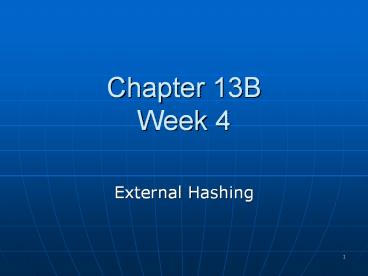Chapter 13B Week 4 - PowerPoint PPT Presentation
1 / 24
Title:
Chapter 13B Week 4
Description:
Each unix file has an inode that contains. File ownership info ... Have the start address contained in the inode point to a table that maps hash ... inode ... – PowerPoint PPT presentation
Number of Views:21
Avg rating:3.0/5.0
Title: Chapter 13B Week 4
1
Chapter 13BWeek 4
- External Hashing
2
External Hashing
- Hashing implemented in secondary storage
3
Static Hashing
- Unix Example
- Each unix file has an inode that contains
- File ownership info
- Access rights
- Location of data
4
Continued
- Have the start address contained in the inode
point to a table that maps hash addresses to
block addresses. - Each block address is called a bucket.
- Each bucket contains multiple records
5
The scheme looks like this
0 1 2 . . . M-1
inode
r1 r2 r3 r4 r5
Buckets are contiguous blocks. Can be one or
several. This one holds five records.
Block Address
Hash function maps key to here
6
Problem Number of buckets is fixed at file
creation
- Maintain a linked list of overflow records for
each bucket.
7
What happens if a bucket is filled
inode
Record pointer contains both block address and
the relative record position within the block
8
Trie-Based Hashing
- Another remedy to the overflow/fixed space
problem - Allow the number of allocated buckets to grow and
shrink as needed - Scheme
- H(K) produces an integer in binary
- Distributes records among buckets based on the
values of the leading bits in their hash values - Mimics a binary tree
9
Insert
- Begin with a bucket of disk addresses
r1 r2 r3 r4
Overflow? Split the bucket (block) based on the
first binary digit of the hash address
0
1
r1 r3 r4 r5
r2
10
Bucket 1 Overflows Again?
- Split on 2nd bit in the hash address
- Suppose we have
- Record Number Hash Address
- r1 0000
- r2 1000
- r3 0010
- r4 0100
- r5 0110
- Insert r6 0111 in the previous structure
11
New Structure
0
1
0
1
r2
r1
r4
r3
r5
r6
12
Find(K)
- Compute h(k)
- Traverse structure based on the binary value of
the hash function - Do linear search of bucket for k
- Go to the disk address contained there
13
Issues
- Hashing function that produces n bit address can
accommodate 2n buckets - Total Records lt 2n NumRecs/bucket
- Hash function should distribute values uniformly
to keep tree balanced - Delete
- Suppose r4, r5, r6 deleted
- Remove pointer to their bucket
- Remove 00/01 internal node
- Reset the 0/1 internal node to point to bucket
containing r1 r3
14
Extendible Hashing
- Replaces the binary tree of dynamic hashing with
a directory consisting of 2d bucket addresses - d is called the global depth of the directory
- First d bits of the hash value is an index into
the array - d is called the local depth
- d lt d
15
Continued
- Not necessarily 2d buckets allocated
- Several directory locations with the same first
d bits for their hash values may point to the
same bucket address when d lt d for a particular
bucket
16
Example
d3
Bucket for records whose hash values start with
000
000
001
b1
010
...
Bucket for records whose hash values start with 01
011
d 2
b2
111
d 3
17
Continued
- Suppose bucket pointed to by 010,011 overflows
- Allocate a new bucket. The old b2 now contains
records whose hash values begin with 010 - The new b3 contains records whose hash values
begin 011 - d of each new bucket is 3
18
Bucket splits
d3
Bucket for recs whose hash starts with 000
000
001
b1
010
...
Bucket for recs whose hash starts with 010
011
d 3
b2
111
Bucket for recs whose hash starts with 011
d3
b3
d 3
19
Increase Table Size
- What happens when dd for some bucket and
overflow occurs? - We need an extra table entry to distinguish the
new value - E.g., 000 overflows we need 0000 and 0001
- Increase d by 1
- Doubles table size
20
Continued
- 0000
- 0001
- 0010
- 0011
- 0100
- 0101
- 0110
- 0111
- .
- .
- .
- 111
d4r1, r2, , rn
d4r1, r2, , rn
d3r1, r2, , rn
d3r1, r2, , rn
21
What if d gt d for all buckets?
- Means that at least two directory positions point
to the same bucket for all buckets - We can now halve the directory
22
Continued
- 000 d 2
- 001
- 010 d 2
- 011
- 100 d 2
- 101
- 110 d 2
- 111
- Halve
- 00 d 2
- 01 d 2
- 10 d 2
- 11 d 2
23
Linear Hashing
- Drawback of trie-based and extendible hashing is
that each requires an auxiliary data structure - Dynamic hashing? binary tree which may not be
balanced - Extendible hashing ? directory
24
Task
- Design a scheme that adjusts size to the amount
of data and requires no auxiliary data structures - Linear Hashing Example




















![NOTE: To appreciate this presentation [and ensure that it is not a mess], you need Microsoft fonts: PowerPoint PPT Presentation](https://s3.amazonaws.com/images.powershow.com/4291458.th0.jpg?_=20131011062)



![NOTE: To appreciate this presentation [and insure that it is not a mess], you need Microsoft fonts: PowerPoint PPT Presentation](https://s3.amazonaws.com/images.powershow.com/5430111.th0.jpg?_=20200818126)






